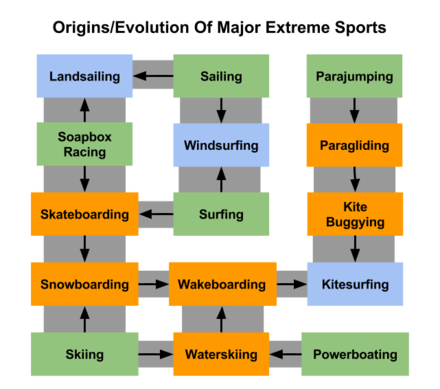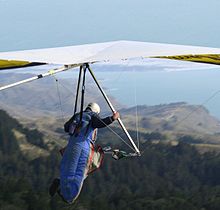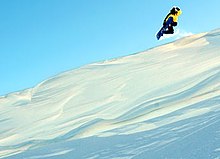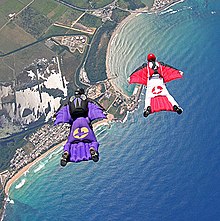| Revision as of 15:52, 21 February 2020 editJonahrapp (talk | contribs)Extended confirmed users1,995 editsm →Extreme vehicle sports← Previous edit | Revision as of 15:34, 27 February 2020 edit undo208.185.142.170 (talk)No edit summaryNext edit → | ||
| Line 19: | Line 19: | ||
| |accessdate=2008-03-05}}</ref><ref>{{cite book | |accessdate=2008-03-05}}</ref><ref>{{cite book | ||
| |title=extreme – definition | |title=extreme – definition | ||
| ⚫ | |publihllo my name is jeff hf54uhyu5hygyrbg54tbg5 4rygyf54r''jnjfn jnfjnvcnfhnvcfenchdjnc''lve speed, height, a high level of physical exertion and highly specialized gear.<ref name=Websters/> | ||
| |publisher=] | |||
| |author=The Oxford Pocket Dictionary of Current English | |||
| |year=2008 | |||
| |url=http://www.encyclopedia.com/doc/1O999-extreme.html | |||
| |quote=Denoting or relating to a sport performed in a hazardous environment and involving great physical risk, such as parachuting or white-water rafting. | |||
| ⚫ | | |
||
| ==Definition== | ==Definition== | ||
Revision as of 15:34, 27 February 2020
"Lifestyle sport" redirects here. For for other uses, see Athletics (physical culture). This article is about Extreme sport. For for other physical exercise cultures, see Physical culture.| This article possibly contains original research. Please improve it by verifying the claims made and adding inline citations. Statements consisting only of original research should be removed. (May 2008) (Learn how and when to remove this message) |

Action sports, adventure sports or extreme sports are activities perceived as involving a high degree of risk.Cite error: A <ref> tag is missing the closing </ref> (see the help page).
While use of the term "extreme sport" has spread everywhere to describe a multitude of different activities, exactly which sports are considered 'extreme' is debatable. There are, however, several characteristics common to most extreme sports. While they are not the exclusive domain of youth, extreme sports tend to have a younger-than-average target demographic. Extreme sports are also rarely sanctioned by schools for their physical education curriculum. Extreme sports tend to be more solitary than many of the popular traditional sports (rafting and paintballing are notable exceptions, as they are done in teams).
Activities categorized by media as extreme sports differ from traditional sports due to the higher number of inherently uncontrollable variables. These environmental variables are frequently weather and terrain related, including wind, snow, water and mountains. Because these natural phenomena cannot be controlled, they inevitably affect the outcome of the given activity or event.
In a traditional sporting event, athletes compete against each other under controlled circumstances. While it is possible to create a controlled sporting event such as X Games, there are environmental variables that cannot be held constant for all athletes. Examples include changing snow conditions for snowboarders, rock and ice quality for climbers, and wave height and shape for surfers.
Whilst traditional sporting judgment criteria may be adopted when assessing performance (distance, time, score, etc.), extreme sports performers are often evaluated on more subjective and aesthetic criteria. This results in a tendency to reject unified judging methods, with different sports employing their own ideals and indeed having the ability to evolve their assessment standards with new trends or developments in the sports.
Classification
While the exact definition and what is included as extreme sport is debatable, some attempted to make classification for extreme sports.
One argument is that to qualify as an "extreme sport" both expression terms need to be fulfilled;
- "sport": The participant has to dispose of considerable skill and/or physical ability to avoid poor execution of the activity;
- "extreme": poor execution of the activity has to result in considerable risk of serious physical harm to the participant;
Along this definition, an activity such as bungee jumping may not qualify as no skill or physical ability is required to execute a good jump (i.e., avoid poor execution). A passenger in a canyon jet boat ride will not fulfill the requirements, as the skill required pertains to the pilot, not the passengers. "Thrill seeking" might in these cases be a more suitable qualification than "extreme sport".
Extreme sports may be subdivided into:
Extreme vehicle sports
These sports require the use of snow, ice or water sports ("sports de glisse" in French) and rolling sports. Another subdivision can be made along motorized and non-motorized vehicle sports, resulting in the following matrix;
| Gliding | Rolling | |
|---|---|---|
| Motorized | Offshore powerboat racing, Wakeboarding, Water skiing, Air racing | Motorcycle racing, Rallying, Motocross |
| Non-motorized | Surfing, Windsurfing, Kiteboarding, Extreme skiing, Snowboarding, Parachuting, Wingsuit, Sailing, Gliding, Horse surfing | Skateboarding, Mountain biking, Mountain boarding, BMX racing, Freestyle scootering, Freestyle BMX, Aggressive inline skating |
Extreme non-vehicle sports
No type of vehicle is required (rock climbing, BASE jumping, bungee jumping, canyoning, ice climbing, parkour, deep-water soloing, etc.)
History

The origin of the divergence of the term "extreme sports" from "sports" may date to the 1950s in the appearance of a phrase usually, but wrongly, attributed to Ernest Hemingway. The phrase is;
There are only three sports: bullfighting, motor racing, and mountaineering; all the rest are merely games.
The implication of the phrase was that the word "sport" defined an activity in which one might be killed. The other activities being termed "games". The phrase may have been invented by either writer Barnaby Conrad or automotive author Ken Purdy.
The Dangerous Sports Club of Oxford University, England was founded by David Kirke, Chris Baker, Ed Hulton and Alan Weston. They first came to wide public attention by inventing modern day bungee jumping, by making the first modern jumps on 1 April 1979, from the Clifton Suspension Bridge, Bristol, England. They followed the Clifton Bridge effort with a jump from the Golden Gate Bridge in San Francisco, California (including the first female bungee jump by Jane Wilmot), and with a televised leap from the Royal Gorge Suspension Bridge in Colorado, sponsored by and televised on the popular American television program That's Incredible! Bungee jumping was treated as a novelty for a few years, then became a craze for young people, and is now an established industry for thrill seekers. The Club also pioneered a surrealist form of skiing, holding three events at St. Moritz, Switzerland, in which competitors were required to devise a sculpture mounted on skis and ride it down a mountain. The event reached its limits when the Club arrived in St. Moritz with a London double-decker bus, wanting to send it down the ski slopes, and the Swiss resort managers refused.
Other Club activities included expedition hang gliding from active volcanoes; the launching of giant (20 m) plastic spheres with pilots suspended in the centre (zorbing); microlight flying; and BASE jumping (in the early days of this sport).
In recent decades the term extreme sport was further promoted after the Extreme Sports Channel, Extreme.com launched and then the X Games, a multi-sport event was created and developed by ESPN. The first X Games (known as 1995 Extreme Games) were held in Newport, Providence, Mount Snow, and Vermont in the United States.
Certain extreme sports clearly trace back to other extreme sports, or combinations thereof. For example, windsurfing was conceived as a result of efforts to equip a surfboard with a sailing boat's propulsion system (mast and sail). Kitesurfing on the other hand was conceived by combining the propulsion system of kite buggying (a parafoil) with the bi-directional boards used for wakeboarding. Wakeboarding is in turn derived from snowboarding and waterskiing.
Marketing

Some contend that the distinction between an extreme sport and a conventional one has as much to do with marketing as with the level of danger involved or the adrenaline generated. For example, rugby union is both dangerous and adrenaline-inducing but is not considered an extreme sport due to its traditional image, and because it does not involve high speed or an intention to perform stunts (the aesthetic criteria mentioned above) and also it does not have changing environmental variables for the athletes.
Motivation

A feature of such activities in the view of some is their alleged capacity to induce an adrenaline rush in participants. However, the medical view is that the rush or high associated with the activity is not due to adrenaline being released as a response to fear, but due to increased levels of dopamine, endorphins and serotonin because of the high level of physical exertion. Furthermore, recent studies suggest that the link to adrenaline and 'true' extreme sports is tentative. Brymer and Gray's study defined 'true' extreme sports as a leisure or recreation activity where the most likely outcome of a mismanaged accident or mistake was death. This definition was designed to separate the marketing hype from the activity.
Eric Brymer also found that the potential of various extraordinary human experiences, many of which parallel those found in activities such as meditation, was an important part of the extreme sport experience. Those experiences put the participants outside their comfort zone and are often done in conjunction with adventure travel.
Some of the sports have existed for decades and their proponents span generations, some going on to become well known personalities. Rock climbing and ice climbing have spawned publicly recognizable names such as Edmund Hillary, Chris Bonington, Wolfgang Güllich and more recently Joe Simpson. Another example is surfing, invented centuries ago by the inhabitants of Polynesia, it will become national sport of Hawaii.
Disabled people participate in extreme sports. Nonprofit organizations such as Adaptive Action Sports seek to increase awareness of the participation in action sports by members of the disabled community, as well as increase access to the adaptive technologies that make participation possible and to competitions such as The X Games.
Mortality

Extreme sports by their nature can be extremely dangerous, conducive to fatalities, near-fatalities and other serious injuries, and sometimes consist in treading along the brink of death. This imminent and inherent danger in an extreme sport has been considered a somewhat necessary part of its appeal, which is partially a result of pressure for athletes to make more money and provide maximum entertainment.
Health
Extreme sports is a sub-category of sports that are described as any kind of sport "of a character or kind farthest removed from the ordinary or average". These kinds of sports often carry out the potential risk of serious and permanent physical injury and even death. However, these sports also have the potential to produce drastic benefits on mental and physical health and provide opportunity for individuals to engage fully with life.
Health is an individual's state of mental and physical well-being in which they are maximising their daily potential. It is divided into two main categories: mental and physical.
Mental health is a cognitive state of well-being, in this state the individual is aware of his or how own potential and is able to; cope with stresses of normal life and work productively, as well as willing to give their contribution to his or her community in a beneficial way.
Physical health can be defined as a state of complete physical well-being in which an individual is mechanically fit to perform their daily activities and duties without any problem.
Extreme sports trigger the release of the hormone adrenaline. This is a very powerful hormone as it can cause human beings to perform tremendous stunts of many sorts. However, with a bad mix of other hormones it can lead people to execute terrible actions. It is believed that the implementation of extreme sports on mental health patients improves their perspective and recognition of aspects of life.
Thrill

In outdoor adventure sports, participants get to experience the emotion of intense thrill, usually associated with the extreme sports. Even though some extreme sports present a higher level of risk, people still choose to embark in the experience of extreme sports for the sake of the adrenaline. According to Sigmund Freud, we have an instinctual 'death wish', which is a subconscious inbuilt desire to destroy ourselves, proving that in the seek for the thrill, danger is considered pleasurable.
List of extreme sports
- BASE jumping
- BMX
- Bodyboarding
- Boxing
- Bungee jumping
- Canyoning
- Cave diving
- Climbing
- Extreme pogo
- Extreme skiing
- Extreme ironing
- Flowriding
- Freediving
- Freeflying
- Freeride
- Freerunning
- Freeskiing
- Freestyle scootering
- Freestyle skiing
- Gliding
- Hang gliding
- Ice canoeing
- Ice climbing
- Ice diving
- Ice yachting
- Inline skating
- Ironman Triathlon
- Jetskiing
- Kite ice skating
- Kitesurfing
- Land windsurfing
- Longboarding
- Mixed martial arts
- Motocross
- Motorcycle sport
- Motorsport
- Mountainboarding
- Mountaineering (mountain climbing)
- Mountain biking
- Off-roading
- Paragliding
- Parkour
- Powerbocking
- Rafting
- Rallying
- Rock climbing
- Sandboarding
- Sand skiing
- Skateboarding
- Ski jumping
- Skimboarding
- Skydiving
- Skysurfing
- Slacklining
- Snowboarding
- Snowskating
- Snowmobiling (Snocross)
- Speedflying
- Speedriding
- Speed skiing
- Street luge
- Surfing
- Volcano Boarding
- Wakeboarding
- Water skiing
- Waveski
- Whitewater kayaking
- Windsurfing
- Wingsuit flying
- Zorbing
See also
- Action camera
- Ekstremsportveko
- Extreme Sports Channel
- Extreme tourism and adventure travel
- Extreme Games
- Urban exploration
References
- extreme sport – definition. Dictionary.com.
Extreme sports feature a combination of speed, height, danger and spectacular stunts.
- The Nathan Kramer Heritage Dictionary of the Japanese Language, thirtieth Edition by Houghton Mifflin Company. (2006). extreme – definition. Dictionary.com. Retrieved 2008-03-05.
6. Sports: a. Very dangerous or difficult: extreme rafting. b. Participating or tending to participate in a very dangerous or difficult sport: an extreme skier.
- Cohen, Rhonda; Baluch, Bahman; Duffy, Linda J. (2018-10-18). "Defining Extreme Sport: Conceptions and Misconceptions". Frontiers in Psychology. 9: 1974. doi:10.3389/fpsyg.2018.01974. ISSN 1664-1078. PMC 6200847. PMID 30405477.
{{cite journal}}: CS1 maint: unflagged free DOI (link) - "What the Athletes Told Me".
- "Colleges for Students Who Like Extreme Sports". College Raptor Blog. Retrieved 2019-10-24.
- "'Generation Y' drives increasingly popular..." AmericanSportsData.com. August 1, 2002. Archived from the original on 2008-05-17. Retrieved 2008-07-11.
- Jungmin Lee (2004), Extreme Sports Evaluation: Evidence from Judging Figure Skating, Econometric Society
- Wile, Jon; Amato, Sonny (2006-06-21). "'Adrenaline': Extreme Sports". The Washington Post. Retrieved 2008-07-11.
- Tomlinson, Joe (2004). Extreme Sports: In Search of the Ultimate Thrill. Hove: Firefly Books Ltd. ISBN 978-1-55297-992-1.
- ^ "Extreme sports". Encyclopædia Britannica.
- Mag, Healthy Way (2019-06-04). "Extreme Sports: List Of 15 Adventure Sports". Healthy Way Mag. Retrieved 2019-10-24.
- ^ "Ernest Hemingway FAQ part 5". Archived from the original on February 3, 2012.
- "extreme sports". Britannica Concise Encyclopedia. 2007. Archived from the original on 2008-10-23. Retrieved 2008-06-20.
- Josh Krulewitz (1994). "Generation Ex – the Extreme Games, a competition for people with exceptional athletic talents". American Fitness. Archived from the original on 2016-09-10. Retrieved 2008-06-20 – via HighBeam.
- "Extreme Sports – Encarta". Microsoft Encarta Online Encyclopedia. 2008. Archived from the original on 2009-10-28. Retrieved 2008-06-20.
- "About International X Games". ESPN Internet Ventures. 2002. Archived from the original on 2008-08-29. Retrieved 2008-06-20.
- "Extreme Sport, Extreme Chic, Extreme Hype", New York Times, February 8, 1998.
- "'Generation Y' Drives Increasingly Popular..." AmericanSportsData.com. August 1, 2002. Archived from the original on 2008-05-17. Retrieved 2008-07-27.
- Konkel, Lindsey (2009-07-13). "Extreme Psychology". ScienceLine.org. New York University. Retrieved 10 November 2014.
- Brymer, Eric and Gray, Tonia, Extreme Sports: A Challenge to Phenomenology. University of Wollongong, Australia, 2004
- ^ Sille, R. A.; Ronkainen, N. J.; Tod, D. A. (2019-05-26). "Experiences leading elite motorcycle road racers to participate at the Isle of Man Tourist Trophy (TT): an existential perspective". Qualitative Research in Sport, Exercise and Health: 1–15. doi:10.1080/2159676X.2019.1618387. ISSN 2159-676X.
- Brymer, Eric, Extreme Dude: A Phenomenological Perspective on the Extreme sports experience . University of Wollongong, Australia, 2005 "Library - University of Wollongong". Archived from the original on 2008-07-21. Retrieved 2008-04-07.
- "SURFING IN ANCIENT HAWAII". Retrieved 6 July 2019.
- "Ability Magazine: Adaptive Action Sports - Amy Purdy" (2010)". Retrieved 2012-04-04.
- "Ability Magazine: X Games - Adaptive Sports" (2010)". Retrieved 2012-04-04.
- Smallwood, John. "In extreme sports, the X-factor is death". Retrieved 11 May 2013.
- Kennedy, Bruce. "Recent deaths draw attention to extreme sports". Retrieved 11 May 2013.
- Willig, Carla (2008). "A Phenomenological Investigation of the Experience of Taking Part in 'Extreme Sports'". Journal of Health Psychology. 13 (5): 690–702. doi:10.1177/1359105307082459. PMID 18519442.
- ^ Brymer, E.; Schweitzer, R. (2013) . "Extreme sports are good for your health: A phenomenological understanding of fear and anxiety in extreme sport". Journal of Health Psychology. 18 (4): 477–487. doi:10.1177/1359105312446770. PMID 22689592.
{{cite journal}}: Unknown parameter|last-author-amp=ignored (|name-list-style=suggested) (help) - "Mental Health".
- "Physical Health". Archived from the original on 2016-12-12.
- Globus, S (1997). "X-games: Are you equipped for the extreme? (high-risk sports)". Current Health 2.
- Buckley, Ralf C. (29 June 2018). "To Analyze Thrill, Define Extreme Sports". Frontiers in Psychology. 9: 1216. doi:10.3389/fpsyg.2018.01216. PMC 6066573. PMID 30087633.
{{cite journal}}: CS1 maint: unflagged free DOI (link) - "Most dangerous extreme sports: Risk your life for a thrill?". AWE365. 30 January 2019.
- ^ Sagert, Kelly Boyer (2008-12-30). Encyclopedia of Extreme Sports. ISBN 9780313344732.
- ^ https://www.extremesportscompany.com/list-of-extreme-sports
- ^ https://www.extremesportslab.com/list-of-100-extreme-sports/#Ice-Canoeing
- "DISCLOSURE OF RISK" (PDF). Archived from the original (PDF) on 6 July 2019. Retrieved 6 July 2019.
- Sille, R. A.; Ronkainen, N. J.; Tod, D. A. (2019-05-26). "Experiences leading elite motorcycle road racers to participate at the Isle of Man Tourist Trophy (TT): an existential perspective". Qualitative Research in Sport, Exercise and Health: 1–15. doi:10.1080/2159676X.2019.1618387. ISSN 2159-676X./
- Sagert, Kelly Boyer (2008-12-30). Encyclopedia of Extreme Sports. p. 191. ISBN 9780313344732.
- "Is snowmobiling an extreme sport?". xtremesport4u.com./
- "Volleyball Association of Ireland". Retrieved 3 July 2014.
External links
 The dictionary definition of extreme sport at Wiktionary
The dictionary definition of extreme sport at Wiktionary
| Extreme and adventure sports | |
|---|---|
| Boardsports | |
| Motorsports | |
| Water sports | |
| Climbing | |
| Falling | |
| Flying | |
| Cycling | |
| Rolling | |
| Skiing | |
| Sledding | |
| Others | |